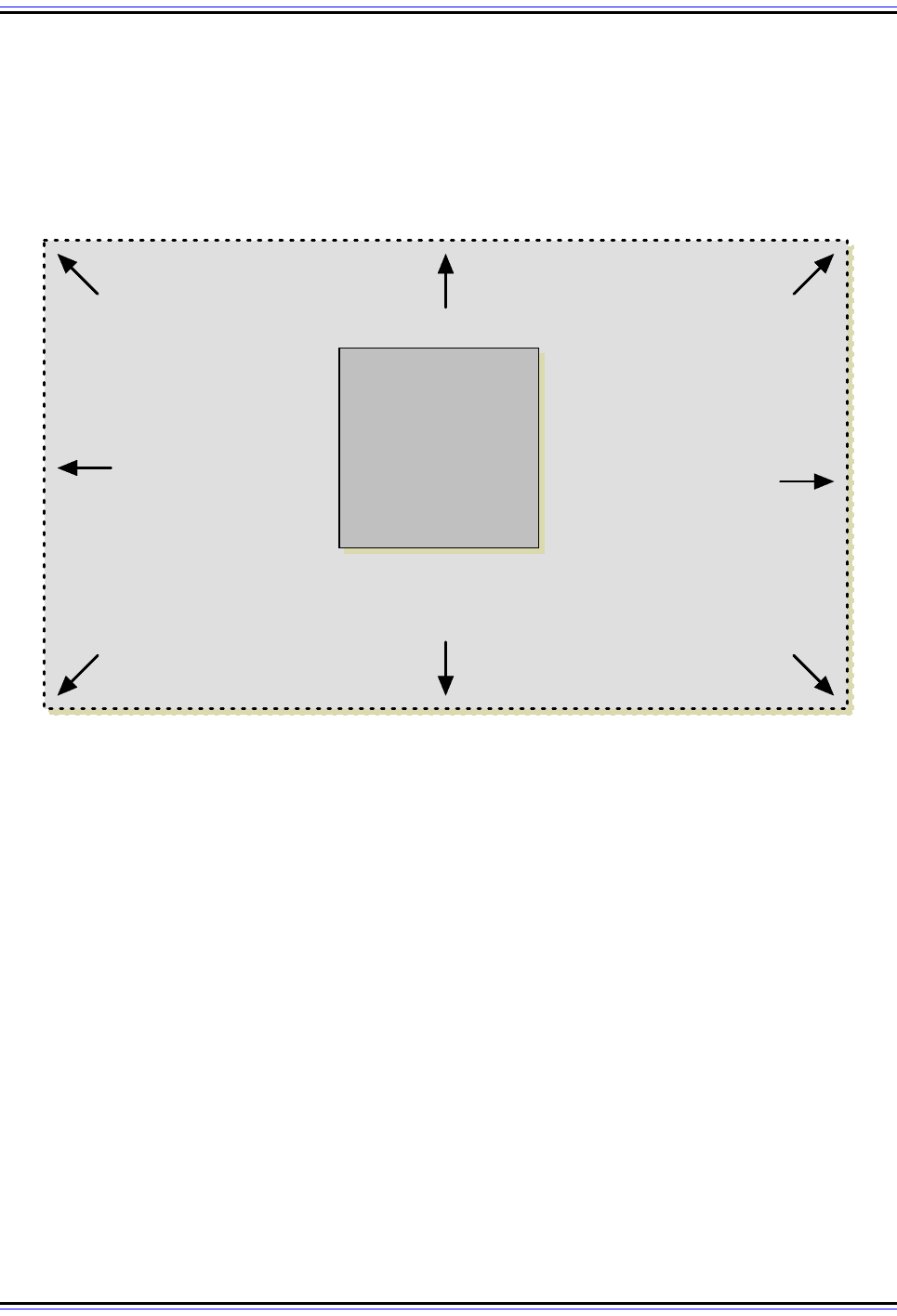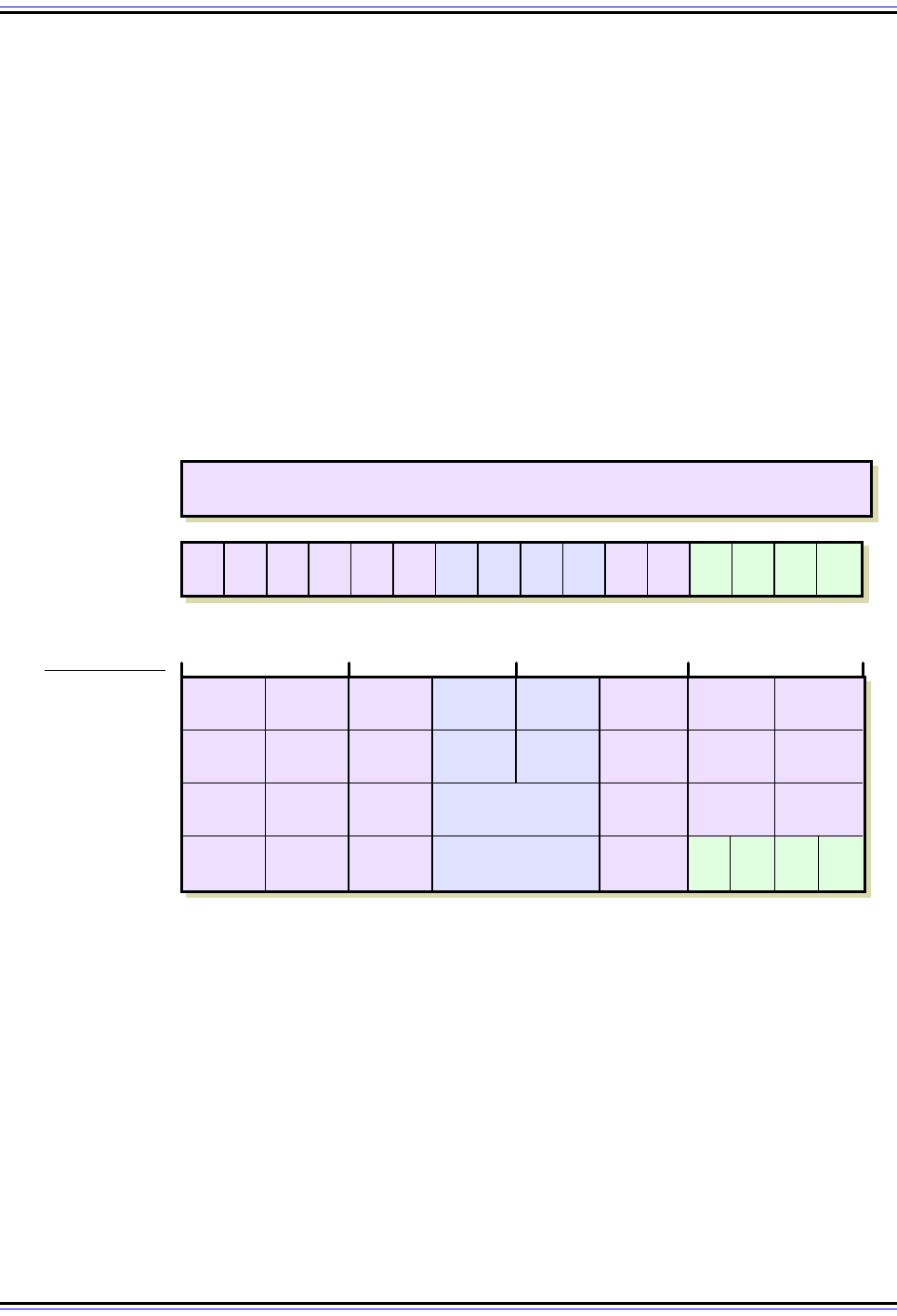Charles M. Kozierok The TCP-IP Guide
Подождите немного. Документ загружается.


The TCP/IP Guide - Version 3.0 (Contents) ` 461 _ © 2001-2005 Charles M. Kozierok. All Rights Reserved.
Key Concept: Due to the many differences between IPv4 and IPv6, and the funda-
mental importance of the Internet Protocol to TCP/IP, an orderly transition has been
planned from IPv4 to IPv6 over a period of many years.
IPv4-IPv6 Transition Methods
Due to the time that change takes, IETF has been working on specific provisions to allow a
smooth transition from version 4 to version 6, and hardware and software interoperability
solutions to let newer IPv6 devices access IPv4 hosts. A technique was included in IPv6 to
allow administrators to embed IPv4 addresses within IPv6 addresses. Special methods are
defined to handle interoperability, including:
☯ “Dual Stack” Devices: Routers and some other devices may be programmed with
both IPv4 and IPv6 implementations to allow them to communicate with both types of
hosts.
☯ IPv4/IPv6 Translation: “Dual stack” devices may be designed to accept requests from
IPv6 hosts, convert them to IPv4 datagrams, send the datagrams to the IPv4 desti-
nation and then process the return datagrams similarly.
☯ IPv4 Tunneling of IPv6: IPv6 devices that don't have a path between them consisting
entirely of IPv6-capable routers may be able to communicate by encapsulating IPv6
datagrams within IPv4. In essence, they would be using IPv6 on top of IPv4; two
network layers. The encapsulated IPv4 datagrams would travel across conventional
IPv4 routers.
Bear in mind that these solutions generally only address backward compatibility, to allow
IPv6 devices to talk to IPv4 hardware. Forward compatibility between IPv4 and IPv6 is not
possible because IPv4 hosts cannot communicate with IPv6 hosts—they lack the
knowledge of how IPv6 works. It is possible that certain special adaptations might be
created to allow IPv4 hosts to access IPv6 hosts. But eventually, all IPv4 devices of any
importance will want to migrate to IPv6.
The IETF has done such a good job in the past with introducing new technologies, and so
much effort has been put into the IPv6 transition, that I am quite confident that the transition
to IPv6 will come off with few, if any, problems. One good thing about the transition is that
IPv4 is, at the present time, still getting the job done, so there is no big hurry to make the
move to version 6. While technologies such as CIDR and NAT are “band-aids” on IPv4, they
have been very successful ones in extending the useful life of the aging protocol.

The TCP/IP Guide - Version 3.0 (Contents) ` 462 _ © 2001-2005 Charles M. Kozierok. All Rights Reserved.
IPv6 Addressing
The primary motivation for creating IPv6 was to rectify the addressing problems in IPv4.
More addresses were required, but more than this, the IPv6 designers desired a way of
interpreting, assigning and using them that was more consonant with modern internet-
working. Based on this, it's no surprise that many of the changes in IPv6 are associated
with IP addressing. The IPv6 addressing scheme is similar in general concept to IPv4
addressing, but has been completely overhauled to create an addressing system capable
of supporting continued Internet expansion and new applications for the foreseeable future.
This section describes the concepts and methods associated with addressing under IPv6. I
begin with a look at some addressing generalities in version 6, including the addressing
model, address types size and address space. I discuss the unique and sometimes
confusing representations and notations used for IPv6 addresses and prefixes. Then I look
at how addresses are arranged and allocated into types, beginning with an overall look at
address space composition and then the global unicast address format. I describe the new
methods used for mapping IP addresses to underlying physical network addresses. I then
describe special IPv6 addressing issues, including reserved and private addresses, IPv4
address embedding, anycast and multicast addresses, and autoconfiguration and renum-
bering of addresses.
Addressing under IPv6 is outlined in the main IPv6 RFC, RFC 2460 (Internet Protocol,
Version 6 (IPv6) Specification). However, most of the details of IPv6 addressing are
contained in two other standards: RFC 3513 (Internet Protocol Version 6 (IPv6) Addressing
Architecture) and RFC 3587 (IPv6 Global Unicast Address Format). These replaced the
1998 standards RFC 2373 (IP Version 6 Addressing Architecture) and RFC 2374 (An IPv6
Aggregatable Global Unicast Address Format).
Background Information: As with the other IPv6 sections in this Guide, our look
at addressing is based somewhat on a contrast to how addressing is done in IPv4.
I strongly recommend a thorough understanding of IPv4 addressing, including
classless addressing using CIDR, before proceeding here. As with the IPv4 addressing
sections, familiarity with how binary numbers work, and conversion between binary and
decimal numbers is also a good idea. The background section on data representation and
the mathematics of computing may be of assistance in that respect.
IPv6 Addressing Overview: Addressing Model and Address Types
In the IPv6 overview section I explained that IPv6 represents a significant update to the
Internet Protocol, but that its modifications and additions are made without changing the
core nature of how IP works. Addressing is the place where most of the differences
between IPv4 and IPv6 are seen, but the changes are mostly in how addresses are imple-
mented and used. The overall model used for IP addressing in IPv6 is pretty much the
same as it was in IPv4; some aspects have not changed at all, while others have changed
only slightly.

The TCP/IP Guide - Version 3.0 (Contents) ` 463 _ © 2001-2005 Charles M. Kozierok. All Rights Reserved.
Unchanged Aspects of Addressing in IPv6
Some of the general characteristics of the IPv6 addressing model that are basically the
same as in IPv4:
☯ Core Functions of Addressing: The two main functions of addressing are still
network interface identification and routing. Routing is facilitated through the structure
of addresses on the internetwork.
☯ Network Layer Addressing: IPv6 addresses are still the ones associated with the
network layer in TCP/IP networks, and are distinct from data link layer (also
sometimes called physical) addresses.
☯ Number of IP Addresses Per Device: Addresses are still assigned to network inter-
faces, so a regular host like a PC will usually have one (unicast) address, and routers
will have more than one, for each of the physical networks to which it connects.
☯ Address Interpretation and Prefix Representation: IPv6 addresses are like
classless IPv4 addresses in that they are interpreted as having a network identifier
part and a host identifier part, but that the delineation is not encoded into the address
itself. A prefix length number, using CIDR-like notation, is used to indicate the length of
the network ID (prefix length).
☯ Private and Public Addresses: Both types of addresses exist in IPv6, though they
are defined and used somewhat differently.
IPv6 Address Types
One important change in the addressing model of IPv6 is the address types supported.
IPv4 supported three address types: unicast, multicast and broadcast. Of these, the vast
majority of actual traffic was unicast. IP multicast support was not widely deployed until
many years after the Internet was established, and continues to be hampered by various
issues. Use of broadcast in IP had to be severely restricted for performance reasons (we
don't want any device to be able to broadcast across the entire Internet!)
IPv6 also supports three address types, but with some changes:
☯ Unicast Addresses: These are standard unicast addresses as in IPv4, one per host
interface.
☯ Multicast Addresses: These are addresses that represent various groups of IP
devices: a message sent to a multicast address goes to all devices in the group. IPv6
includes much better multicast features and many more multicast addresses than
IPv4. Since multicast under IPv4 was hampered in large part due to lack of support of
the feature by many hardware devices, support for multicasting is a required, not
optional, part of IPv6.
☯ Anycast Addresses: Anycast addressing is used when a message must be sent to
any member of a group, but does not need to be sent to them all. Usually the member
of the group that is easiest to reach will be sent the message. One common example
of how anycast addressing could be used is in load sharing amongst a group of routers
in an organization.

The TCP/IP Guide - Version 3.0 (Contents) ` 464 _ © 2001-2005 Charles M. Kozierok. All Rights Reserved.
Key Concept: IPv6 has unicast and multicast addresses like IPv4. There is,
however, no distinct concept of a broadcast address in IPv6. A new type of address,
the anycast address, has been added to allow a message to be sent to any one
member of a group of devices.
Implications of the Changes to Address Types in IPv6
Broadcast addressing as a distinct addressing method is gone in IPv6. Broadcast function-
ality is implemented using multicast addressing to groups of devices. A multicast group to
which all nodes belong can be used for broadcasting in a network, for example.
An important implication of the creation of anycast addressing is removal of the strict
uniqueness requirement for IP addresses. Anycast is accomplished by assigning the same
IP address to more than one device. The devices must also be specifically told that they are
sharing an anycast address, but the addresses themselves are structurally the same as
unicast addresses.
The bulk of the remainder of this section focuses on unicast addressing, since it is by far the
most important type. Multicast and anycast addressing are given special attention
separately.
IPv6 Address Size and Address Space
Of all the changes introduced in IPv6, easily the most “celebrated” is the increase in the
size of IP addresses, and as a result, the increase in the size of the address space as well.
It's not surprising that these sizes were increased compared to IPv4—everyone has known
for years that the IPv4 address space was too small to support the future of the Internet.
What's remarkable is just how much the increase is, and what the implications are for how
Internet addresses are used.
IPv6 Address Size
In IPv4, IP addresses are 32 bits long; these are usually grouped into four octets of eight
bits each. The theoretical IPv4 address space is 2
32
, or 4,294,967,296 addresses. To
increase this address space we simply increase the size of addresses; each extra bit we
give to the address size doubles the address space. Based on this, some folks expected
the IPv6 address size to increase from 32 to 48 bits, or perhaps 64 bits. Either of these
numbers would have given a rather large number of addresses.
However, IPv6 addressing doesn't use either of these figures; instead, the IP address size
jumps all the way to 128 bits, or sixteen 8-bit octets/bytes. This represents a truly
remarkable increase in the address size, which surprised a lot of people.

The TCP/IP Guide - Version 3.0 (Contents) ` 465 _ © 2001-2005 Charles M. Kozierok. All Rights Reserved.
IPv6 Address Space
The 128 bits of IPv6 addresses mean the size of the IPv6 address space is, quite literally,
astronomical; like the numbers that describe the number of stars in a galaxy or the distance
to the furthest pulsars, the number of addresses that can be supported in IPv6 is mind-
boggling. See Figure 94 for an idea of what I mean by “astronomical”.
Since IPv6 addresses are 128 bits long, the theoretical address space if all addresses were
used is 2
128
addresses. This number, when expanded out, is
340,282,366,920,938,463,463,374,607,431,768,211,456, which is normally expressed in
scientific notation as about 3.4*10
38
addresses. That's about 340 trillion, trillion, trillion
addresses. As I said, it's pretty hard to grasp just how large this number is. Consider:
☯ It's enough addresses for many trillions of addresses to be assigned to every human
being on the planet.
☯ The earth is about 4.5 billion years old. If we had been assigning IPv6 addresses at a
rate of 1 billion per second since the earth was formed, we would have by now used up
less than one trillionth of the address space.
Figure 94: A (Poor) Representation of Relative IPv4 and IPv6 Address Space Sizes
I wanted to make a cool graphic to show the relative sizes of the IPv4 and IPv6 address spaces. You know,
where I’d show the IPv6 address space as a big box and the IPv4 address space as a tiny one. The problem
is that the IPv6 address space is so much larger than the IPv4 space that there is no way to show it to scale!
To make this diagram to scale, imagine the IPv4 address space is the 1.6-inch square above. In that case, the
IPv6 address space would be represented by a square the size of the solar system. ☺
IPv4 Address Space
(4,294,967,296
Addresses)
IPv6 Address Space
(340,282,366,920,938,463,463,374,607,431,768,211,456 Addresses)

The TCP/IP Guide - Version 3.0 (Contents) ` 466 _ © 2001-2005 Charles M. Kozierok. All Rights Reserved.
☯ The earth's surface area is about 510 trillion square meters. If a typical computer has a
footprint of about a tenth of a square meter, we would have to stack computers 10
billion high blanketing the entire surface of the earth to use up that same trillionth of
the address space.
Okay, I think you get the idea. It's clear that one goal of the decision to go to 128-bit
addresses is to make sure that we will never run out of address space again, and it seems
quite likely that this will be the case.
Key Concept: The IPv6 address space is really, really big. ☺
Why Were IPv6 Addresses Made So Large?
However, there are drawbacks to having such a huge address space too. Consider that
even with a 64-bit address, we'd have a very large address space: 2
64
is
18,446,744,073,709,551,616 or about 18 million trillion, still probably more addresses than
we will ever need. However, by going instead to 128 bits we have made dealing with IP
addresses unruly (as we'll see in the next topic) and we have also increased overhead,
since every datagram header or other place where IP addresses are referenced must use
16 bytes for each address instead of the 4 that were needed in IPv4, or the 8 that might
have been required with a 64-bit address.
So why the “overkill” of going to 128 bits? The main reason is flexibility. Even though we
can have a couple zillion addresses if we allocate them one at a time, that makes
assignment difficult. We got rid of class-oriented addressing in IPv4 due to the fact that it
wasted address space, which is true. The reality, though, is that being able to “waste”
address space is a useful luxury.
Having 128 bits allows us to divide the address space and assign various purposes to
different bit ranges while still not having to worry about running out of space. In the topic
describing the IPv6 global unicast address format we'll see one way that those 128 bits are
put to good use; it allows us to create a hierarchy of networks while still saving 64 bits for
host IDs, which has its own advantages.
IPv6 Address and Address Notation and Prefix Representation
Increasing the size of IP addresses from 32 bits to 128 bits expands the address space to a
gargantuan size, ensuring that we will never again run out of IP addresses, and allowing us
flexibility in how they are assigned and used. Unfortunately, there are some drawbacks to
this method, and one of them is that 128-bit numbers are very large, which makes them
awkward and difficult to use.

The TCP/IP Guide - Version 3.0 (Contents) ` 467 _ © 2001-2005 Charles M. Kozierok. All Rights Reserved.
IPv6 Addresses: Too Long For Dotted Decimal Notation
Computers work in binary, and they have no problem dealing with long strings of ones and
zeroes, but humans find them confusing. Even the 32-bit addresses of IPv4 are
cumbersome for us to deal with, which is why we use dotted decimal notation for them
unless we need to work in binary (as with subnetting). However, IPv6 addresses are so
much larger than IPv4 addresses that even using dotted decimal notation becomes
problematic. To use this notation, we would split the 128 bits into 16 octets and represent
each with a decimal number from 0 to 255. However, we would end up not with 4 of these
numbers, but 16. A typical IPv6 address in this notation would appear as follows:
128.91.45.157.220.40.0.0.0.0.252.87.212.200.31.255
The binary and dotted decimal representations of this address are shown near the top of
Figure 95. In either case, the word “elegant” doesn't exactly spring to mind.
IPv6 Address Hexadecimal Notation
To make addresses shorter, the decision was made in IPv6 to change the primary method
of expressing addresses to use hexadecimal instead of decimal. The advantage of this is
that it requires fewer characters to represent an address, and that converting from hex to
binary and back again is much easier than converting from binary to decimal or vice-versa.
Figure 95: Binary, Decimal and Hexadecimal Representations of IPv6 Addresses
The top two rows show binary and dotted decimal representations of an IPv6 address; neither is commonly
used (other than by computers themselves!) The top row of the lower table shows the full hexadecimal repre-
sentation, while the next two rows illustrate zero suppression and compression. The last row shows mixed
notation, where the final 32 bits of an IPv6 address are shown in dotted decimal notation. This is most
commonly used for embedded IPv4 addresses.
Dotted
Decimal
Binary
Hexadecimal
1000000001011011001011011001110111011100001010000000000000000000
0000000000000000111111000101011111010100110010000001111111111111
128 91 45 157 220 40 0 0 0 0 252 87 212 200 31 255
805B 2D9D DC28 0000 0000 FC57 D4C8 1FFF
805B 2D9D DC28 0 0 FC57 D4C8 1FFF
805B 2D9D DC28 :: FC57 D4C8 1FFF
805B 2D9D DC28 :: FC57 212 200 31 255
Straight Hex
Leading-Zero
Suppressed
Zero-
Compressed
Mixed Notation
96
32 64 1280

The TCP/IP Guide - Version 3.0 (Contents) ` 468 _ © 2001-2005 Charles M. Kozierok. All Rights Reserved.
The disadvantage is that many people, even computer people, find hexadecimal difficult to
comprehend and work with, especially because the notion of 16 values in each digit is a bit
strange. (I'm not one of them, but then I'm a geek.)
The hexadecimal notation used for IPv6 addresses is similar to the same method used for
IEEE 802 MAC addresses, for technologies like Ethernet. There, 48 bits are represented by
six octets, each octet being a hexadecimal number from 0 to FF, separated by a dash or
colon, like this:
0A-A7-94-07-CB-D0
Since IPv6 addresses are larger, they are instead grouped into eight 16-bit words,
separated by colons, to create what is sometimes called colon hexadecimal notation, again
shown in Figure 95. So, the IPv6 address given in the example above would be expressed
as:
805B:2D9D:DC28:0000:0000:FC57:D4C8:1FFF
To keep size down, leading zeroes can be suppressed in the notation, so we can immedi-
ately reduce this to:
805B:2D9D:DC28:0:0:FC57:D4C8:1FFF
Hmm. Well, it's definitely shorter than dotted decimal, but still not much fun to look at. When
you are dealing with numbers this big, there's only so much you can do. This is part of why
under IPv6, use of DNS names for hosts becomes much more important than it is in IPv4;
who could remember a hex address that long?!
Zero Compression in IPv6 Addresses
Fortunately, there is a short-cut that can be applied to shorten some addresses even
further. This technique is sometimes called zero compression. The method allows a single
string of contiguous zeroes in an IPv6 address to be replaced by a double-colon. So, for
example, the address above could be expressed as:
805B:2D9D:DC28::FC57:D4C8:1FFF
We know how many zeroes are replaced by the “::” because we can see how many fully-
expressed (“uncompressed”) hex words are in the address. In this case there are six, so the
“::” represents two zero words. To prevent ambiguity, the double-colon can appear only
once in any IP address, because if it appeared more than once we could not tell how many
zeroes were replaced in each instance. So, if our example address were
805B:2D9D:DC28:0:0:FC57:0:0, we could replace either the first pair of zeroes or the
second, but not both.
Zero compression doesn't make our example much shorter, but due to how IPv6 addresses
are structured, long strings of zeroes are common. For example, consider this address:
FF00:4501:0:0:0:0:0:32

The TCP/IP Guide - Version 3.0 (Contents) ` 469 _ © 2001-2005 Charles M. Kozierok. All Rights Reserved.
With compression, this could be expressed as just:
FF00:4501::32
It works even better on special addresses. The full IPv6 loopback address is:
0:0:0:0:0:0:0:1
With compression, this is simply:
::1
For even more fun, consider the Even more odd, the IPv6 “unspecified” address:
0:0:0:0:0:0:0:0
Apply zero compression to an address that is all zeroes, and what do you get? That’s right:
::
No numbers at all! Of course thinking of “::” as an address does take some getting used to.
Key Concept: For brevity, IPv6 addresses are represented using eight sets of four
hexadecimal digits, a form called colon hexadecimal notation. Additional techniques,
called zero suppression and zero compression, are used to reduce the size of
displayed addresses further by removing unnecessary zeroes from the presentation of the
address.
IPv6 Mixed Notation
There is also an alternative notation used in some cases, especially for expressing IPv6
addresses that embed IPv4 addresses. For these, it is useful to show the IPv4 portion of the
address in the older dotted decimal notation, since that's what we use for IPv4. Since
embedding uses the last 32 bits for the IPv4 address, the notation has the first 96 bits in
colon hexadecimal notation, and the last 32 bits in dotted decimal. So to take our same
example again from above, in mixed notation it would be shown as:
805B:2D9D:DC28::FC57:212.200.31.255
This isn't really a great example of mixed notation, because embedding usually involves
long strings of zeroes followed by the IPv4 address. Thus, zero compression comes in very
handy here. Instead of seeing something like this:
0:0:0:0:0:0:212.200.31.255

The TCP/IP Guide - Version 3.0 (Contents) ` 470 _ © 2001-2005 Charles M. Kozierok. All Rights Reserved.
You will typically see just:
::212.200.31.255
At first glance this appears to be an IPv4 address; you have to keep a close eye on those
colons in IPv6!
Key Concept: A special mixed notation is defined for IPv6 addresses whose last 32
bits contain an embedded IPv4 address. In this notation, the first 96 bits are
displayed in regular colon hexadecimal notation, and the last 32 bits in IPv4-style
dotted decimal.
IPv6 Address Prefix Length Representation
Like IPv4 classless addresses, IPv6 addresses are fundamentally divided into a number of
network ID bits followed by a number of host ID bits. The network identifier is called the
prefix, and the number of bits used is the prefix length. This prefix is represented by
following the address by a slash and then putting the prefix length after the slash. This is the
same method used for classless IPv4 addressing with CIDR. For example, if the first 48 bits
of our example address were the network ID (prefix), then we would express this as
805B:2D9D:DC28::FC57:D4C8:1FFF/48.
Key Concept: In IPv6 the size of an address’s prefix is indicating by the prefix length
that follows the address, separated with a slash, just as this is done in IPv4 classless
addressing.
As in IPv4, specifiers for whole networks will typically end in long strings of zeroes. These
can be replaced by “::” using zero compression. For example, the 48 bit network ID for the
example above is 805B:2D9D:DC28:0:0:0:0:0/48, or 805B:2D9D:DC28::/48. You must
include the “::” if replacing the trailing zeroes.
IPv6 Address Space Allocation
After dealing for so many years with the very small IPv4 address space, the enormous
number of addresses in IPv6 must have made the IETF engineers feel like kids in a candy
shop. They were good kids, however, and didn't run wild grabbing all the candy they could
find and gobbling it up. They very carefully considered how to divide the address space for
various uses. Of course, when you have this much candy, sharing becomes pretty easy.
